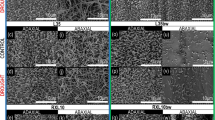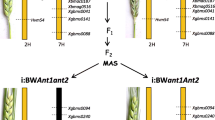Abstract
Many barley landraces are purple-or black-seeded, but the chemical composition of these purple-and black- seeded barley is rarely examined. Therefore, studies were conducted to determine if the chemical composition of purple and black barleys differs from that of yellow barleys. Four sets of genetic materials were used for these studies: 96 doubled-haploid (DH) lines, 10 near-isogenic lines, 40 landraces, and four F3 bulks. The results showed that purple DH lines contained a similar amount of lignin as yellow DH lines and that anthocyanin-containing isogenic lines did not differ from anthocyanin-free lines in lignin content. Therefore, these results suggest that anthocyanin biosynthesis is independent of lignin biosynthesis in barley. The results also showed that black barley contained more protein and more lignin than yellow barley in two crosses and that among the 40 landraces studied, the three with the highest concentration of lignin happened to be black seeded. Lignin content was not associated with seed weight except in defective endosperm lines. The presence of pigments and a relatively high concentration of lignin might help reduce the level of kernel blight severity in black barley. More studies are needed to determine the chemical composition and pest resistance associated with purple and black barleys.
Similar content being viewed by others
Abbreviations
- DH:
-
doubled haploid
- ADF:
-
acid-detergent fibre
- NDF:
-
neutral detergent fibre
- AOAC:
-
Association of Official Analytical Chemists
References
AOAC, 1995. Official Methods of Analysis 16th edn. Association of Official Analytical Chemists, Washington, DC.
S. Ceccarelli S. Grando (1999) Barley landraces from the Fertile Crescent: A lesson for plant breeders. S.B. Brush (Eds) Genes in the Field: On-farm Conservation of Crop Diversity IPGRI/IDRC/Lewis Publishers Boca Raton, FL 51–76
J. Frégeau-Reid T.M. Choo K.M. Ho R.A. Martin T. Konishi (2001) ArticleTitleComparisons of two-row and six-row barley for chemical composition using doubled-haploid lines Crop Sci. 41 1737–1743 Occurrence Handle10.2135/cropsci2001.1737
K.M. Ho A. Tekauz T.M. Choo R.A. Martin (1996) ArticleTitleGenetic studies on net blotch resistance in a barley cross. Can J. Plant Sci. 76 715–719
B. Jende-Strid (1988) ArticleTitleCoordinator’s Report: Anthocyanin genes Stock list of ant mutants kept at the Carlsberg Laboratory. Barley Genet. Newslett. 18 74–79
B. Jende-Strid (1998) ArticleTitleBGS 599, Proanthocyanidin-free 17, ant17 Barley Genet. Newslett. 29 88–89
P.Y. Jui T.M. Choo K.M. Ho T. Konishi R.A. Martin (1997) ArticleTitleGenetic analysis of a two-row×six-row cross of barley using doubled-haploid lines Theor. Appl. Genet. 94 549–556
F. Kebebew Y. Tsehaye T. McNeilly (2001) ArticleTitleMorphological and farmers cognitive diversity of barley (Hordeum vulgare L. [Poaceae]) at Bale and North Shewa of Ethiopia Genet. Resour. Crop Evol. 48 467–481
Z. Li J. Xie S. Zhang T. Zhang Y Rao (2001) New black barley variety ’Gan Mai No. 1’. (in Chinese, with English abstract) X. Liu D. Ma (Eds) Barley Science in China, vol. 5. China Agricultural Science and Technology Press Beijing 139–143.
Ma D. 2000. Genetic Resources of Tibetan Barley in China. China Agriculture Press, Beijing (In Chinese).
P. Narasimhalu D. Kong T.M. Choo (1998) ArticleTitleStraw yields and nutrients of 75 Canadian barley cultivars Can. J. Anim. Sci. 78 127–134 Occurrence Handle10.4141/A97-020 Occurrence Handle1:CAS:528:DyaK1cXjslSmsbs%3D
R.L. Nicholson R. Hammerschmidt (1992) ArticleTitlePhenolic compounds and their role in disease resistance Annu. Rev. Phytopathol. 30 369–389 Occurrence Handle1:CAS:528:DyaK3sXhvFWguw%3D%3D
E. Nordkvist A.-C. Salomonsson P. Aman (1984) ArticleTitleDistribution of insoluble bound phenolic acids in barley grain J. Sci. Food Agric. 35 657–661 Occurrence Handle1:CAS:528:DyaL2cXksFelsLk%3D
M.V. Reddy J. Arul P. Angers L. Couture (1999) ArticleTitleChitosan treatment of wheat seeds induces resistance to Fusarium graminearum and improves seed quality J. Agric. Food Chem. 47 1208–1216 Occurrence Handle1:CAS:528:DyaK1MXptVSntQ%3D%3D
Riis P., Vaag P. and Peetz J. (1995.) Influence of barley variety on Fusarium field infection. In: Proc. Eur. Brew. Conv., Brussels, pp. 117-124
J.B. Rowe G.B. Crosbie (1988) ArticleTitleThe digestibility of grain of two cultivars of oats differing in lignin content Aust. J. Agric. Res. 39 639–644
SAS Institute Inc, 1997. The SAS system for Windows. Release 6.12. SAS Inst., Cary, NC.
B. Skadhauge K.K. Thomsen D. Wettstein Particlevon (1997) ArticleTitleThe role of the barley testa layer and its flavonoid content in resistance to Fusarium infections Hereditas 126 147–160 Occurrence Handle1:CAS:528:DyaK2sXls1WrtL0%3D
E. Siranidou Z. Kang H. Buchenauer (2002) ArticleTitleStudies on symptom development, phenolic compounds and morphological defence responses in wheat cultivars differing in resistance to Fusarium head blight J. Phytopathol. 150 200–208
D.M. Tolbert C.O. Qualset S.K. Jain J.C. Craddock (1979) ArticleTitleA diversity analysis of a world collection of barley Crop Sci. 19 789–794 Occurrence Handle10.2135/cropsci1979.0011183X001900060011x
C.P. Vance T.K. Kirk R.T. Sherwood (1980) ArticleTitleLignification as a mechanism of disease resistance Annu. Rev. Phytopathol. 18 259–288 Occurrence Handle1:CAS:528:DyaL3cXls1Chtb8%3D
P.J. Soest Particlevan G.B. Robertson B.A. Lewis (1991) ArticleTitleSymposium: carbohydrate methodology, metabolism, and nutritional implications in dairy cattle J. Dairy Sci. 74 3583–3597 Occurrence Handle1660498 Occurrence Handle10.3168/jds.S0022-0302(91)78551-2
Author information
Authors and Affiliations
Corresponding author
Rights and permissions
About this article
Cite this article
Choo, T.M., Vigier, B., Ho, K.M. et al. Comparison of black, purple, and yellow barleys. Genet Resour Crop Evol 52, 121–126 (2005). https://doi.org/10.1007/s10722-003-3086-4
Received:
Accepted:
Issue Date:
DOI: https://doi.org/10.1007/s10722-003-3086-4




